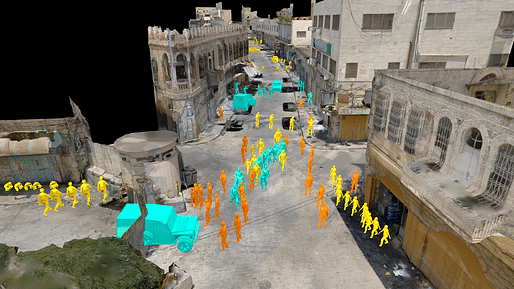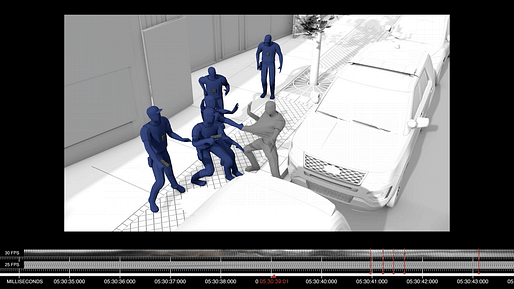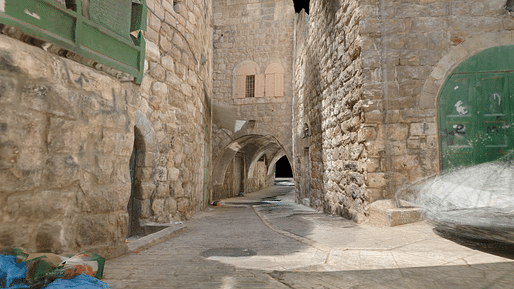

Forensic Architecture's first United States survey exhibition, Forensic Architecture: True to Scale, made its debut last week at Miami's Museum of Art and Design at Miami Dade College.
The exhibition, according to a press release, "explores a new understanding of architecture, a new evidentiary aesthetic, and a new form of coalition activism," and is going public as news surfaces that Forensic Architecture director Eyal Weizman was denied a visa to visit the United States for the exhibition's opening by Department of Homeland Security authorities. Weizman's visa application was denied because "an algorithm had identified a security threat that was related to him," The New York Times reports. Weizman published an open letter describing the situation on the Forensic Architecture website.
The exhibition in Miami highlights a collection of Forensic Architecture's recent research projects, which instrumentalize conventional tools of architectural practice—3-D modeling, photogrammetry, and other digital approaches—to show "that it is both possible and imperative to verify what is really happening in the world around us," Weizman explains in an exhibition statement. The practice, which includes architects, software developers, filmmakers, journalists, lawyers, artists, and scientists, creates documentary and forensic analyses of contested events that take place in volatile environments, many of these projects have been used as evidence in court cases, tribunals, United Nations assemblies, and in publications, according to the group.

For example, one project, The Killing of Harith Augustus, recently exhibited at the 2019 Chicago Architecture Biennial, investigates of the police shooting death of Harith Augustus, a 37-year-old African-American man was shot to death by police officers in Chicago's South Shore neighborhood. The investigation interrogates the "split-second" decision-making process police often cite to explain their decision to use deadly force. For the investigation, Forensic Architecture, in partnership with the Invisible Institute and others, reconstructs the killing of Augustus through the lens of six different time scales as a way of exploring different facets of police violence, from the milliseconds surrounding confrontation that took his life, to the contested events that took place in the days following the killing, to the historical trajectory of various phenomena that came together in the deadly event itself. The video series uses 3-D reconstructions drawn from various body and dashboard camera records of the killing to visualize and pinpoint the details of the shooting event from a variety of vantages. The publication of Forensic Architecture's analysis ultimately led the Chicago Civilian Office of Police Accountability to release its own footage of the killing.
At the Miami exhibition, all six videos created for the investigation will be shown. (In the Chicago installation of this project, not all of the videos were shown out of respect to the victim's family.)

Another project, Hebron: Testimonies of Violence (2018–20), investigates the deadly assault of a Palestinian man who was killed by a member of the Israeli army in the occupied city of Hebron in 2017.
The project represents Forensic Architecture's first use of virtual reality applications to "assist, record, and represent witness testimony," according to a press statement. For the investigation, which is co-produced by MOAD and is making its public debut with the exhibition, Forensic Architecture uses digital modeling approaches to create an inhabitable virtual reality realm that people who are giving testimony for the trail can experience to help jog their memories. According to the firm, "More than proving a single incident, the resulting model records the daily reality of violence and harassment experienced by Palestinians under occupation."
The exhibition will be supported with a series of panel discussions and events that help to teach Forensic Architecture's methodologies to a wider audience while laying the groundwork for "an investigation of the alleged human rights violations occurring within a nearby child migrant detention center," the exhibition press release states.
“This exhibition offers an opportunity to rethink the agency of design museums,” explained Sophie Landres, MOAD’s Curator of Public Programs, adding, “Forensic Architecture teaches us what tools are available to verify truth claims amidst our currently murky and disorienting media environment. They inspire us to take an active role in the pursuit of social justice.”
No Comments
Block this user
Are you sure you want to block this user and hide all related comments throughout the site?
Archinect
This is your first comment on Archinect. Your comment will be visible once approved.